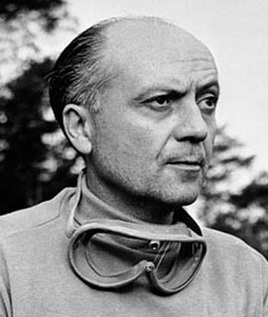Pierre Levegh facts for kids
 |
|
| Born | 22 December 1905 Paris, France |
|---|---|
| Died | 11 June 1955 (aged 49) Le Mans, France |
| Formula One World Championship career | |
| Active years | 1950 – 1951 |
| Teams | privateer Talbot-Lago |
| Entries | 6 (6 starts) |
| Championships | 0 |
| Wins | 0 |
| Podiums | 0 |
| Career points | 0 |
| Pole positions | 0 |
| Fastest laps | 0 |
| First entry | 1950 Belgian Grand Prix |
| Last entry | 1951 Italian Grand Prix |
Pierre Eugène Alfred Bouillin (born December 22, 1905 – died June 11, 1955) was a French sportsman and racing driver. He chose the racing name Pierre Levegh to honor his uncle, Alfred Velghe, who was also a famous driver and passed away in 1904. Levegh died in a terrible accident during the 1955 24 Hours of Le Mans race, which also sadly killed many spectators.
Contents
Pierre Levegh's Racing Career
Pierre Levegh was born in Paris, France. Besides being a racing driver, he was also good at other sports like ice hockey and tennis.
In the world of motorsport, he raced in Formula One for the Talbot-Lago team in 1950 and 1951. He started six races but didn't score any points.
Le Mans Races
Levegh raced at the famous 24 Hours of Le Mans race four times for the Talbot team.
- In 1951, he finished in fourth place.
- In 1952, he was driving by himself and had a big lead in the race. But with only an hour left, his car had an engine problem. Many people thought he was too tired, but the problem was actually a loose part in the engine. Levegh didn't let his co-driver take over because he believed only he could keep the car going. He ended up losing the race.
- In 1953, he finished eighth.
- In 1954, he was involved in an accident during the race.
The 1955 Le Mans Accident
In 1955, Pierre Levegh joined the American driver John Fitch to race a Mercedes-Benz 300 SLR. This was at the 24 Hours of Le Mans race.
How the Accident Happened
About three hours into the race, a Jaguar D-Type driven by Mike Hawthorn suddenly slowed down to enter the pit stop area. This caused the Austin-Healey 100S of Lance Macklin to swerve to avoid Hawthorn. Macklin's car moved into the path of Levegh's faster Mercedes.
Levegh's car hit Macklin's car, launched into the air, and crashed into a wall. The car broke apart, and pieces flew into the crowd of spectators. Levegh was sadly killed instantly when he was thrown from his car. The Mercedes car, which had a body made of a material called magnesium, quickly caught fire.
Aftermath of the Tragedy
The combination of the fire and flying car parts tragically killed 83 spectators and injured over 100 more. The race was continued to prevent a large number of spectators from leaving all at once, which would have blocked roads needed for ambulances.
Some people believe Levegh may have saved the life of five-time Formula One World Champion Juan Manuel Fangio. Fangio said that Levegh gave him a hand signal to slow down just moments before the crash, which he believes saved him from being in the accident too.
After the accident, Mercedes decided to stop racing in the event as a sign of respect for the victims. Meanwhile, Mike Hawthorn and Ivor Bueb continued racing their Jaguars and won the race.
The accident led to big changes in how motor racing was viewed. It made people realize that race tracks needed to be much safer for both spectators and drivers. Because of this tragedy, Mercedes stopped all motor racing for the next 30 years. A small British company called Bristol Cars also decided to stop racing completely. John Fitch, Levegh's co-driver, became a strong supporter of car safety and started researching ways to make cars safer, which helped improve safety in motorsport.
Pierre Levegh is buried in the Père Lachaise Cemetery in Paris.
See also
 In Spanish: Pierre Levegh para niños
In Spanish: Pierre Levegh para niños

